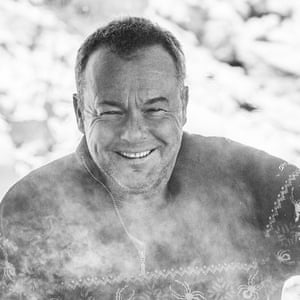 |
| The wolf of Main Street by David Yarrow. Photograph: David Yarrow |
David Yarrow's best photograph: a wolf on the prowl in a wild west saloon
‘I asked the barman if he minded me bringing a wolf into the bar. “What’ll he have?” he said’Dave Hall
Thy 25 Jan 2018
I
have always felt a visceral pull towards ghost towns. I find abandonment and decay much more evocative than growth and prosperity. Virginia City, an abandoned mining town in Montana, was perfect.
It was the dead of winter in 2015 and snow was thick on the ground. We had been working all day on a couple of set pieces in temperatures of -20C with a large crew, a mountain lion, a wolf and their trainers. On this type of project, the right shot can take all day, and we were just about to wrap, as the light was fading and the temperature dropping. We’d planned to stop by the town bar, so we could warm up with a restorative drink.
The bar was straight out of Pale Rider, exactly what you’d expect a wild west saloon to be. The barman, Rosie, had that world-weary look about him. There was a long wooden surface you could imagine glasses of beer sliding along, with a moose’s head and faded black and white photographs of the glory years on the walls. When I saw that late afternoon light catching the long bar, I realised I had to do this shot.
So I asked Rosie if he minded us bringing a wolf into his bar. “What’ll he have?” he said in reply. And that’s how this photo happened. We decided everyone should behave as if a wolf in the bar was perfectly normal: Rosie would be pulling beers, a customer would be reading the paper, there’d be a game of pool going on. And the focus would be the wolf’s eyes – they had to be sharp.
This meant the wolf had to be at eye level, so we used the bar as his catwalk. Now, he may have been trained but ultimately a wolf is still a wolf. The challenge was how to get him to walk towards my camera. Rosie unearthed some chicken fillets and we tied them around my neck. This proved effective: the wolf moved with some excitement towards me and we nailed the shot in four takes.
Much of my wildlife work is done with a remote-control camera, which may be in place for weeks near a pride or a herd as I lurk in the brush nearby waiting for that perfect moment. Other projects are more conceptual: they involve a lot of research and planning, as well as a crew and a budget. A recent shoot I did in Namibia required three models, three roadies, one cheetah and two handlers. That wasn’t cheap, as we were in the desert and everyone had to be flown in. I pay for everything, because one big image can sell for $1m. We need to get it right, though, because a bad image will sell for nothing.
Critics often take issue with the staged shots not being authentic. Others argue I put myself in unnecessary danger. I do not. Every risk is a calculated one. And, either way, we are doing some good. We are now able to raise £1m a year for Tusk, the elephant conservation charity. That matters most to me. I used to work in the City, and I like to think I am of more use now than I was sitting at my trading screen all day.
A large print of this image now hangs proudly behind the bar. It has become a tourist attraction. I use it to prove a point: the day’s never over until it’s over.
David Yarrow’s CV
Born: Glasgow, 1966.
Studied: Business at Edinburgh University.
Influences: Ridley Scott, Andy Murray, Robert Capa.
High point: “Shooting in the south Sudan in 2017.”
Low point: “Getting divorced in 2006.”
Top tip: “Attack, attack, attack.”



No comments:
Post a Comment